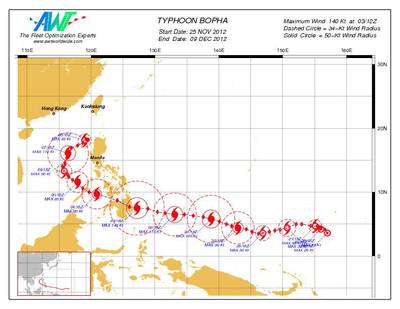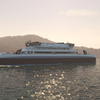Route Spotlight:
Avoid Costly Voyages with Eco-Steaming & Weather Routing.
In the recent financial climate, eco-steaming has proven to be profitable while also being good for the environment. However, a shipping company must always be aware of the prevailing weather situation in relation to their fleet.
This article deals with a ship's route options while approaching Typhoon Bopha in December, 2012. The suffering attributed to the passage of Bopha was well documented in the news around the world. This late-season typhoon set numerous records for strength and destruction.
In the case studied here, a bulk carrier was taking the normal route from Japan to Indonesia, passing south of Mindanao. The vessel was sailing at eco-speed to save fuel and reduce in CO2 emissions. However, Bopha formed ESE of the Philippines during late November.
AWT closely monitored the progress of this storm and developed close communication with clients whose vessel might be affected by the storm. In this instance, a discussion was initiated with regards to increasing speed, stopping, or course adjustments for storm avoidance.
Speed increases have some merit, but come at the cost of increased consumption. Additionally, speed adjustments may have limited benefits. A speed increase of 1 knot will only move a ship further along the track by 24 NM/day. It would take 2.5 days of such a speed increase to make 60NM (1 degree of latitude). The non-linear relationship between speed and consumption might increase consumption some 20%-25% for this 7-9% increase in speed.
After discussion, it was agreed to recommend that the captain take an alternate course via Surigao Strait in the Philippines, with the addition of only about 20NM. After ensuring sufficient charts were on-board, the master concurred with the recommendation and the harmful effects of the storm were avoided.
If the vessel had stayed on its original path, she would have encountered typhoon force northerly, backing west-southwesterly conditions passing east of Mindanao with significant wave heights greater than 15 meters along the direct route. The ship would have been caught directly west of the storm, with nowhere to turn, as discussed above. In the image below, one can see 10 + meter waves extending more than 1 degree further to the south, so the 1 knot speed increase for 2-3 days might have lessened the ship's exposure to the worst conditions, but still exposed the ship to waves exceeding 10 meters in height.
It is calculated that a negligible 1.7 MT fuel oil was added to what would have been consumed along the shortest route. Alternatively, had the speed of the ship been increased along the shortest route, it is calculated that higher speed would have been required for at least two full days, with additional consumption of perhaps 15 MT IFO.
Therefore, the close communication between AWT and the shipping company enabled the company to save about 9,000 USD in this instance while ensuring safety of ship and crew. Conversely, the vessel might have lost about 2 days waiting for storm passage.











